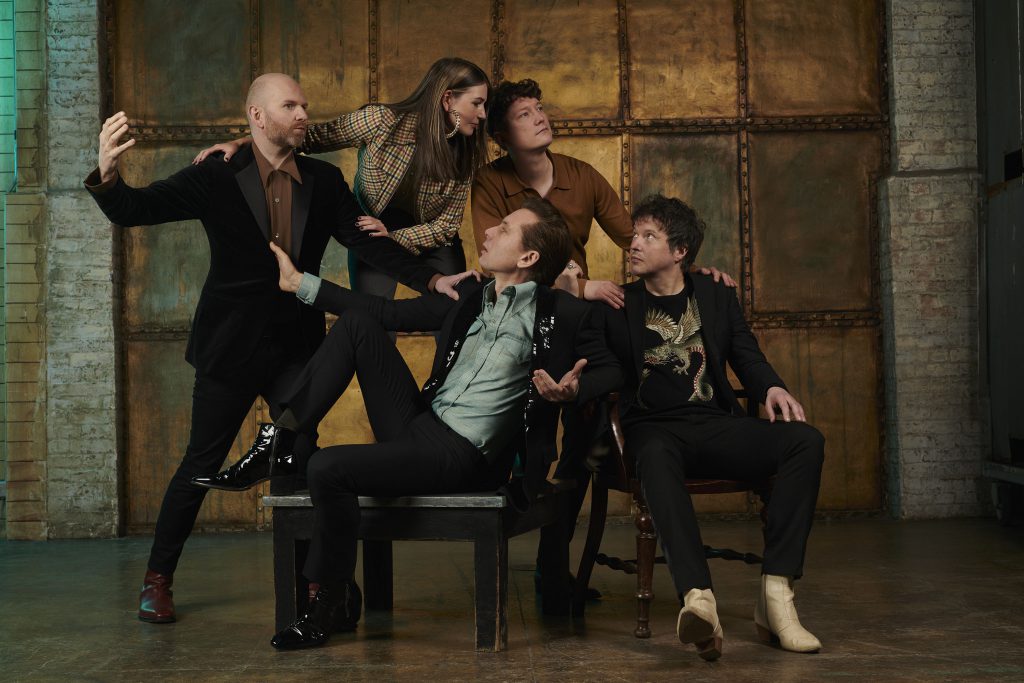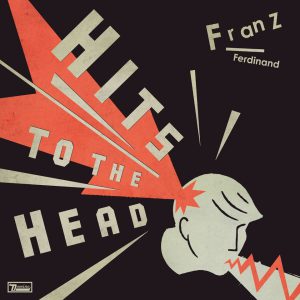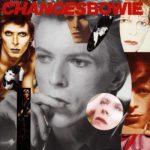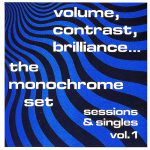Alex Kapranos of Franz Ferdinand picks his favorite best-of albums

Franz Ferdinand, courtesy David Edwards.
Alex Kapranos of Franz Ferdinand is looking angelic with a sheet of backlighting through a skylight in his band’s Glasgow studio. Though the video connection is a little fuzzy, he can spot the “Do You Want To” single cover tucked away at the back of this writer’s office.
Hits To The Head
Franz Ferdinand
Domino, March 11
“That’s my friend Roxanne Clifford, who was in Veronica Falls,” the 49-year-old says of the woman on the cover. “She took the very first photos of us as well, the ones that were on the inside of the first album. I think there’s a photograph where I’m jumping off an amplifier, but sorry, I digress.”
One thing you should know: Alex Kapranos strongly dislikes looking backward; he’s all about the future. Over five albums since 2004’s self-titled breakout, Franz Ferdinand has steadily (and sometimes not so steadily) evolved. There was never an attempt to write a second “Darts of Pleasure” or “Take Me Out.” Little of the band’s original sound exists on 2018’s Always Ascending.
But he’s giving it a shot now because Franz Ferdinand is about to release its new retrospective, Hits To The Head, a 20-track collection of hits and other songs close to the band that he, bassist Bob Hardy (41) and newer members Julian Corrie, Dino Bardot and Audrey Tait selected.
“I’m not a nostalgic person, and I don’t really enjoy those conversations that people have, like, ‘Do you remember when, blah blah blah?'” Kapranos says. “I like looking forward to the future and particularly as an artist, which I think is why the album is like it is.”
He means the album’s two new singles, “Billy Goodbye” and “Curious,” which Franz Ferdinand recorded right before sending all the songs to the pressing plant. Kapranos separates retrospectives into two groups. The first is someone’s complete work and life. The second is for artists who are still creating and growing.
“I, just before the pandemic, went to a Francis Bacon retrospective at the Pompidou in Paris. And I loved it, but that’s like a retrospective in the sense of everything is the past, that you look back over the lifetime and the finite ending to it,” he says. “I went to Martin Creed at the Armory in New York or Tracey Emin at The South Bank in London, and both of those artists were living artists, and you saw right from their first beginnings with both of them, there was work from their time in art school, again, right up to the very present day. Those retrospectives work as a way of understanding the past, bringing us to the present day and then understanding what the future might be and making us excited about the future. Because it’s the future, as I keep on saying, which is what I truly find exciting. It allows us to step into the past to look at the future.”
With that mindset, RIFF asked Kapranos to list off his favorite career retrospectives by other artists, as well as what would make the cut for a retrospective of Franz Ferdinand’s lesser-known songs, B-sides and other rarities.
Favorite retrospectives by others
“Well, the one for me as a kid, which was a big one, was Changesbowie [by David Bowie]. I love that album, very inspiring for me and also interesting because I think ‘singles Bowie’ and ‘albums Bowie’ are different characters. Changes has a very different personality from any of his other albums.
Even Ziggy Stardust, which is like the kind of album where every song feels like it could almost be a single, but it’s very much of one period, whereas Changes just feels like a masterpiece. It’s astonishing and also what I love in a good retrospective is seeing two things: the progression of work, and seeing the evolution, and in his case, exploring different sounds and identities.
Yet, the consistency of character, the consistency of personality—you hear that it’s Bowie on every song; instantly recognizable, and I love that.
Next one I’d say is Louder than Bombs by the Smiths. I love that album. I can listen to it as an album in its own right, and I don’t really have to necessarily think of it as a compilation album. I had all the Smiths albums when I was younger. I still have them, you know. … That was a great one. It just always put me in a good mood.
The next two are the Red and Blue albums by the Beatles just because they were such a big part of my childhood growing up. Massively inspiring.
The next one—I wonder if it’s like one of the greatest hits albums ever—which is Queen’s Greatest Hits, the first volume. Again, a big album for me when I was a kid. My parents weren’t the kind of people who had a lot of money to spend on records, so they did have greatest hits records. I love how they were a glimpse into an artist’s life. My mom could never have been [bothered] with the more obscure album tracks on a Queen album. She just wouldn’t have enjoyed them, but Queen’s Greatest Hits was great for her, and I love the kind of egalitarianism anti-snobbish nature of a greatest hits album.
It’s like, ‘I don’t care if you’re not like a total music aficionado. If you want to just enjoy the hits, that’s fine; that’s cool! Enjoy them; that’s great.’ If you’re not like that, if you’re interested in the B-sides, the obscurities and the demos, fuckin’ you enjoy that as well, but one approach is not necessarily superior to the other.
I would say, Volume, Contrast, Brilliance…, The Monochrome Set’s compilation of all of the early singles and stuff, because a lot of those songs didn’t end up on albums and things that are in that form, and I just love The Monochrome Set. Not enough people know about them, and I love to give them a plug because they’re a brilliant band, and like criminally underappreciated; Bid, Lester Square—they were great songwriters. I wish more people would have them in their lives because it would make their lives better.
On a Franz Ferdinand retrospective album of B-sides
It’s a record I’d love to make. I really feel we should. I like the idea of making a Hits to the Back of the Head or something like that. I feel there are a lot of songs which I really love which never got the exposure that a single or an album track would get. Songs like “L. Wells,” for example … which was a B-side out with “The Fallen.” We used to play it live around our second album, and it always felt like such a big song live. A lot of fans really connected with that song. “Love and Destroy” is another one.
“Shopping for Blood” and “Van Tango” on the first EP. There’s other songs as well, which never had a release, which I’d love to get out there. When we recorded the first album there was a version of “Can’t Stop Feeling” we recorded for that album with a totally different melody for the instrumental part and totally different delivery. For the second album, there was a version of “Turn It On” which we never included, and we did a different version on the third album.
On the fourth album there was a song called “Scarlet and Blue,” which we played live a lot around about that time, which we recorded, but I never liked the versions that we mixed or recorded. I deliberately wouldn’t release it because I felt it wasn’t as good as it should have been. But really, that should have been the lead single off that album. It was by far the most single-type song that we’ve done.
Off that record as well, there were two songs that ended up on the BNQT album: “Hey Banana” and “Fighting the World.” I’d like to put the original versions of that out, which we recorded. There was also a version that we recorded, or that I certainly demoed, of “Little Guy From the Suburbs,” [off the Franz Ferdinand Sparks (FFS) album] which was much more of an upbeat disco banger, which I wish we’d kept like that. I feel recording it as an acoustic song really kind of squandered it. I’d like to put out that version of that song.
I can see it being at least 20 songs worth of an album. Or even … like our cover of [LCD Soundsystem’s] “All My Friends” or things like that. There’s fucking hundreds of them. I tend to be quite exacting when it comes to releases, and if I feel that a song doesn’t meet the standards, I’d rather not release it then put it out as a shit version of what it should be. So some of the songs just never got released because I felt the recordings weren’t right. But looking back, maybe those versions should be released. Maybe in the context of an album like that, it would be good to release them. I might have been wrong at the time as well—who knows—maybe I’m not the one to judge.
On the new Franz Ferdinand visual aesthetic
I really like Bob’s new look. I think it really suits him. I think it’s fascinating how he made the transition from a cherub to assassin.
We love the visual side of the band as much as the musical side of the band, and everything from the design of the the artwork to the way the records are put together to the videos, and to the photographs. I love working on that stuff. It was fun developing some new ideas for these shoots. There’s a whole bunch of other photographs that will be coming out as well that kind of play with some some great visual tricks that we haven’t put out there yet.
There’s one which has been going out which I really loved. We were trying to recreate the kind of composition which you would find in a Renaissance painting. I always loved going a to a gallery like the the Tate in London, or the National Portrait Gallery, and seeing these huge Renaissance canvases, where you have all these figures. It’s usually some kind of Biblical scene they’re enacting.
They’re stunning, and they kind of lay out all the characters. They’re usually relating to the betrayal of somebody or the revelation of the head of John the Baptist or whatever. And then people are around about them, and the way they represent action, because they’re based on people who are posing in real life. They capture action in a really unrealistic way, but the lack of realism has an extra realism to it. There’s something “beyond realism” about them, which I really loved.
I wanted to try and capture something like that, within the context of a photograph and so that’s why we have, again, these absurd Renaissance poses.
Follow editor Roman Gokhman at Twitter.com/RomiTheWriter.






